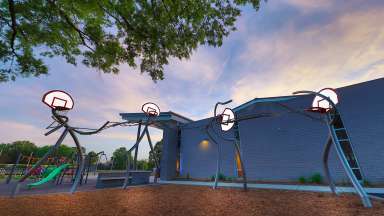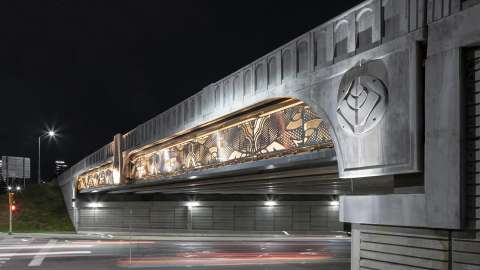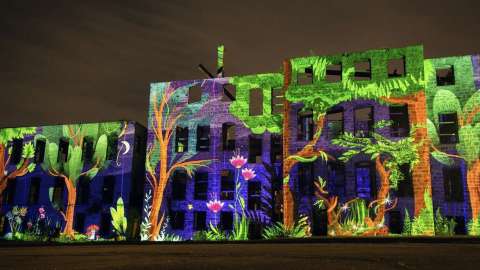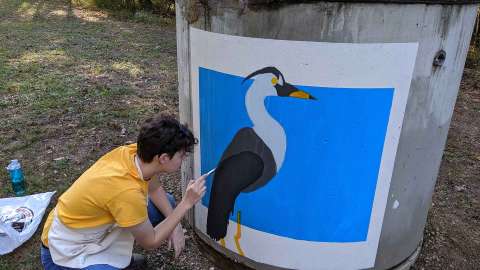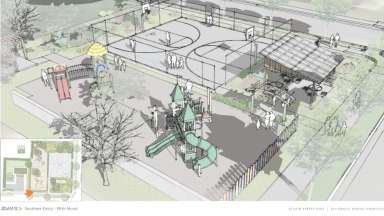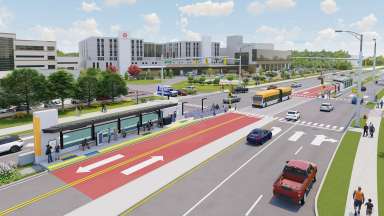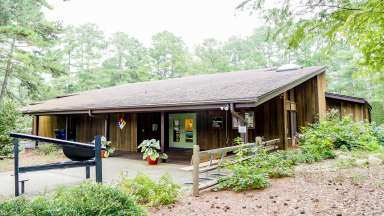Jump To:
Permanent Public Art Projects
A permanent public art project is typically an original, site-specific work of art that is designed to remain in place for more than five years. In Raleigh, these projects have mostly been commissioned in conjunction with major capital projects to enhance those projects and have usually been funded through Percent for Art funds, sometimes with additional fundraising. These projects can be created in a wide variety of forms, such as stand-alone sculptures, functional design elements, or aesthetic enhancements integrated into a project or building design. Permanent projects commissioned by the public art program become a permanent part of the Municipal Art Collection.
How do permanent public art projects support the goals for public art in Raleigh?
Goal 1: Nurture artists, arts professionals, and organizations to build Raleigh’s public art ecosystems
- Permanent public art opportunities can be organized so that artists of all experience levels, from those who are new to public art to those with high levels of experience, can be commissioned.
- Permanent projects can provide opportunities for artists who work in a variety of styles, scales, and materials.
- Permanent projects allow artists to expand their practice by exploring new ideas or materials.
- Artists commissioned to develop permanent public art can mentor regional artists who are new to public art.
Goal 2: Leverage the Public Art Process to Connect Raleigh’s Communities
- By engaging residents in the envisioning, production, and programming of permanent public art, the program (and the artists it works with) can create places of meaning and identity in a community.
- Through permanent projects, the program can inspire viewers to imagine their own creative potential and civic voices, regardless of their circumstances, and strengthen their ability to participate actively in civic processes.
- Permanent artworks can become part of the city’s visual landscape and provide ways for people to create individual and shared connections to places.
- Permanent artworks can be reinterpreted over time, particularly through formal or informal creative activations.
Goal 3: Build a Creative Bridge Between the Activities of City Government, Raleigh’s Arts Community, and the People Who Live in, Work in, and Visit the City
- Permanent public art can enhance the design of facilities the city builds, including civic buildings, parks, greenways, streetscapes, and infrastructure systems.
- Permanent public art can impact the design of places developed by the City or private developers by making them more approachable, welcoming, or memorable, and thereby more connected to the communities where they are located.
Goal 4: Build Equitable, Inclusive, and Accessible Public Art Processes
- Artists can create permanent artworks that share the stories of underrepresented communities, thereby making those stories part of the City’s legacy.
When is permanent public art the right tool?
- Permanent public art projects should be commissioned when:
- The department leading the capital project is interested in creating an artwork that will be a permanent feature of their project.
- The sponsor of a private development project is interested in creating an artwork that will be a permanent feature of their project.
- There is a recommendation in an area plan that suggests that a permanent artwork is appropriate.
- The site is appropriate for a permanent artwork, in terms of the likelihood that public access and visibility will be maintained for the foreseeable future, and the likelihood that artwork will be safe and unlikely to be threatened by future development.
- There is an adequate budget to plan, design, fabricate, install, and maintain an artwork, considering factors such as the level of public participation and rigor in design, fabrication, and installation that are required for a permanent artwork.
- There is a commitment to maintain the artwork after it is completed.
How is a permanent public art project funded?
Permanent projects are typically funded by Percent for Art Funds, which means allocating 1% of the overall budget (of a public work or capital improvement project) to fund a public art project. Percent for Art funds are the most common source of funds for permanent public art projects, but permanent projects can also be supported through grants, partnerships, and private fundraising.
What is a typical timeline for a permanent public art project?
Permanent public art projects usually follow the same timeline as the public works project they are associated with. The overall timeline is usually 2 to 5 years. The first 6 months to 2 years are taken up with community engagement and planning. After the Public Art Board approves the artwork design, then the artist will spend 6 months to 1 year creating the artwork. (When delays occur, it is typically because the associated public works project has a stretched-out timeline.) Install usually happens quickly in a matter of days or weeks.
Temporary Public Art Projects
A temporary public art project is an artwork that is expected to be on site for five years or less, or work that is meant to deteriorate over time and will not be replaced or maintained, regardless of its budget.
Temporary projects can be very versatile. Like permanent artworks, temporary public art can be created in a wide range of media. However, as temporary public art projects are not necessarily tied to public works projects, they often have lower budgets, can be planned more quickly, and can be sited more flexibly, in locations where artists, communities and the public art program see opportunities for artworks to have the most impact and/or where permanent artworks might not be possible.
Temporary artworks are not maintained the way that permanent artworks are. Unlike permanent artworks, they are not necessarily created to be durable, sometimes made with materials that may not be long-lasting in outdoor environments.
The public art program has directly supported temporary public art through SEEK Raleigh, a periodic series of temporary, site-specific art installations and performance art events that engage the community. SEEK, which is funded by the public art program, is structured to be responsive to ideas generated by artists for locations that they identify. Through SEEK, installations and performances have been created for a variety of parks, greenways, and/or community spaces, including one series focused specifically on Dorothea Dix Park.
The public art program has also commissioned temporary artworks and creative education projects through partnerships with other City departments.
How do temporary public art projects support the goals for public art in Raleigh?
Goal 1: Nurture artists, arts professionals, and organizations to build Raleigh’s public art ecosystems
- Temporary projects may be more appealing and more realistic “next steps” for artists who have not created a public art project before, helping to expand the public art ecosystem.
- Because temporary projects can have fewer infrastructural demands, they can provide successful outlets for the creative agency of a wider range of artists and other people.
Goal 2: Leverage the Public Art Process to Connect Raleigh’s Communities
- Because temporary projects can be located more flexibly throughout the city, they can be planned for locations that are accessible to more people.
- Because temporary projects are time-limited, they can attract and focus people’s attention, generating conversation and connection.
Goal 3: Build a Creative Bridge Between the Activities of City Government, Raleigh’s Arts Community, and the People Who Live in, Work in, and Visit the City
- Temporary projects can help the community imagine potential futures by drawing attention to a specific civic issue or place that warrants attention, connecting a cross-section of the community in public conversation.
- Temporary artworks can prototype or test ideas for new public spaces that are yet to be created and/or build constituencies for new places.
- Temporary public art projects can be designed to creatively engage neighbors and gather community input related to a capital project.
Goal 4: Build Equitable, Inclusive, and Accessible Public Art Processes
- Because temporary artworks can be built with shorter lead times, they can allow artists to be more responsive to timely civic issues, particularly issues of economic, environmental, and racial justice.
When are temporary public art projects the right tool?
Temporary public art projects should be commissioned when:
- There is an interest in engaging an artist in a civic issue that is important to the community or neighborhood. Because temporary public art projects take can take less lead time in planning, they can be responsive in real time to civic issues.
- There is interest in instigating and/or supporting local creative approaches to investigating places or creating work around a specific topic or idea.
- There is an interest in activating public space by creating a feature that can only be experienced for a limited time.
- There is an opportunity to mark a particular moment in time, such as an important anniversary or current event.
How are temporary public art projects funded?
Temporary public art can be funded through Per Capita Funds, partnerships with other public agencies, and Percent for Art funds if the work is commissioned in support of a capital project that generates Percent for Art funds. Grant funding and private fundraising can also support these projects.
What is a typical timeline for a temporary public art project?
Temporary projects have a lifetime of 5 years or less. This category can include performances that last for a single night, sculptures with a set life span, projection mapping projects, temporary murals, and many other types of ephemeral artwork.
Do-It-Yourself Public Art Projects
Do-It-Yourself Public Art Projects are public art projects proposed, funded, and developed by individuals and organizations on City-owned property. The public art program facilitates the review and approval process for all Do-It-Yourself Public Art Projects, from small-scale temporary installations to larger-scale, permanent works of art. The review and approval process in the Public Art Policy outlines steps that encourage the development of innovative and creative public art projects while also ensuring coordination with city departments that have responsibilities related to the proposed project.
Large-scale, permanent public art projects that are to be accessioned into the Municipal Art Collection require approval from the PADB, CORAC and City Council. Smaller-scale, temporary projects have a more streamlined application and review process, with CORAC providing final approval.
How Do-It-Yourself Public Art Projects support the goals for public art in Raleigh
Goal 1: Nurture artists, arts professionals, and organizations to build Raleigh’s public art ecosystems
- The Do-It-Yourself Public Art Project process encourages artists and organizations working with artists to develop public art projects.
Goal 2: Leverage the Public Art Process to Connect Raleigh’s Communities
- The review process for Do-It-Yourself Public Art Project encourages project sponsors to develop public artworks that are meaningful to the community.
- A streamlined process for smaller community-initiated projects enables communities to engage directly in organizing and undertaking projects, building agency and creative voice, and encouraging connection.
Goal 3: Build a Creative Bridge Across the Activities of City Government, Raleigh’s Arts Community, and the People Who Live in, Work in, and Visit the City
- City departments review proposals and work with the community to ensure that the artwork does not negatively impact the use of public space, aligns with future planning for the site, and has the best opportunity to succeed.
- City departments responsible for the infrastructure where smaller-scale
- Community-initiated projects can be located to encourage these projects to help enliven public space and encourage community stewardship of public resources.
Goal 4: Build Equitable, Inclusive, and Accessible Public Art Processes
- The Do-It-Yourself Public Art Projects model reduces barriers to access for individuals and organizations to initiate projects.
When are Do-It-Yourself Public Art Project the right tool?
Individuals and organizations are guided to the Do-It-Yourself Public Art Project process when they have an interest in installing artwork on City property. Interested applicants are encouraged to begin working with the public art program early to ensure that they are developing the necessary application materials and following best practices.
Do-It-Yourself Public Art Projects
How are Do-It-Yourself Public Art Project funded?
Do-It-Yourself Public Art Projects are self-funded by the organization or individual who is bringing the idea to Raleigh Arts.
What is a typical timeline for a Do-It-Yourself Public Art Project?
There is usually a 1 to 3 month turnaround to get a Do-It-Yourself Public Art Project approved. After that, the installation timeline can vary based on the project, but most projects are installed within 3 months of approval. These projects can have a lifespan of anywhere from a few days to many years, depending on the nature of the project and the longevity of the materials involved.
